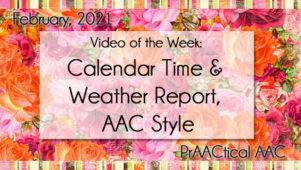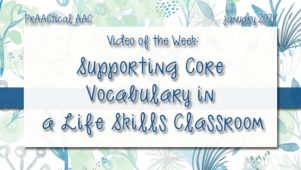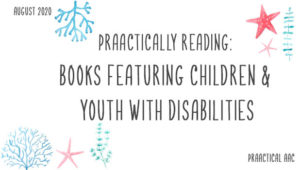PrAACtically Reading with Karen Natoci: April Fool’s Day
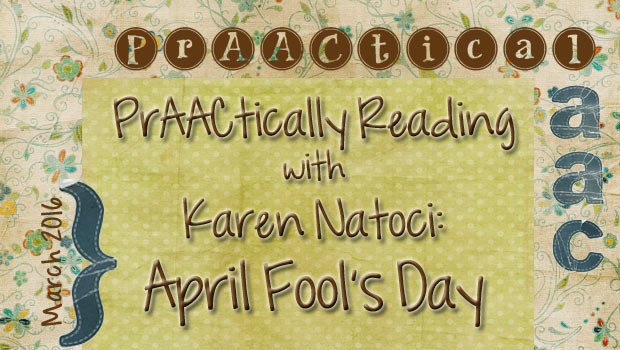
It’s gratifying to hear from so many of you who are including storybook reading in your AAC instruction and therapy. We welcome back Karen Natoci,  Assistant Professor and SLP Oregon Health and Science University’s Child Development Rehabilitation Center. She serves on the Neurodevelopment and Rett Evaluation teams and has a caseload of children with Complex Communication Needs and AAC. Karen tells us that “I know very well the feeling of being overwhelmed by the high needs of students with complex communication needs and will readily admit that you have to have a very large ‘toolbox’ of ideas!” Currently, she is on the charter development team to create the Communication Matrix- Virtual Community of Practice with Charity Rowland. At the end of the day, Karen enjoys running, practicing piano, and exploring Portland and the Oregon coast.
Assistant Professor and SLP Oregon Health and Science University’s Child Development Rehabilitation Center. She serves on the Neurodevelopment and Rett Evaluation teams and has a caseload of children with Complex Communication Needs and AAC. Karen tells us that “I know very well the feeling of being overwhelmed by the high needs of students with complex communication needs and will readily admit that you have to have a very large ‘toolbox’ of ideas!” Currently, she is on the charter development team to create the Communication Matrix- Virtual Community of Practice with Charity Rowland. At the end of the day, Karen enjoys running, practicing piano, and exploring Portland and the Oregon coast.
::::::::::::::::::::::::::::::::::::::::::::::::::::::::::::::::::::::::::::::::::::::::::::::::::
Book: April Fool’s Day Written and Illustrated by Dee Smith (Also available from Deesignery.com)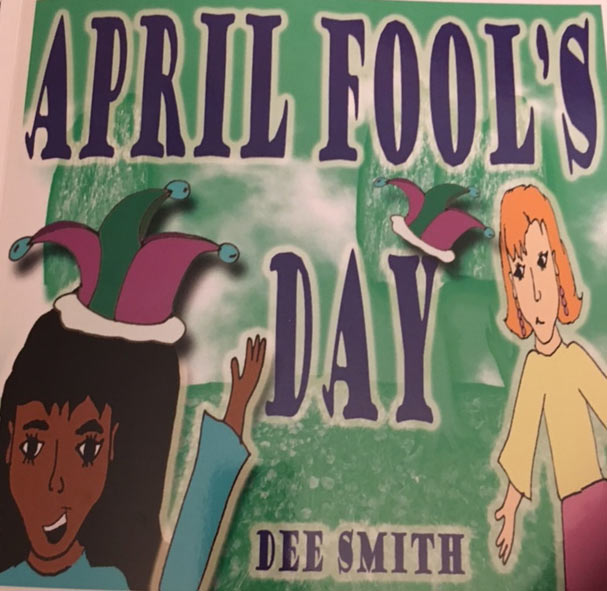
Core Vocabulary focus: Look, uh-oh, who, turn, more, what, that, go, want, like, funny, yum
Fringe Vocabulary focus: hat, silly, friend, pie, colors, fruit, mother, paper, crayons, paint, paper, glue, pan, foil.
Communication Matrix (Rowland, 2009) level: III-VII
April Fool’s Day is a great time to plan a funny and friendly prank. In this story, a girl plays a prank on her friend and they laugh about it together! As I searched for books on this topic, I wanted to find one that was easy to read, promoted some good core language and provided a real life activity to deepen comprehension. I remember attending the Intensive Literacy course taught by Karen Erickson and David Koppenhaver where I learned about the benefits of a good prank, leading to great reasons to communicate with the added emotion of surprise! Inspired by this idea, I am happy to share the book, April Fool’s Day by Dee Smith. At the end, a silly paper “pie” is baked which allows the reader to act out the book to deepen comprehension while being silly! Before we read the book; however, it is recommended that talking about PIES is a good idea!
Start by building background knowledge about two things: (1) Pies and then, (2) April Fool’s Day.
- Look up images of pies, watch videos about pies, make a pie in class, sample some pies as a science activity! Spend an hour talking all about pies! This can make a great afternoon snack the day before actually reading the story (Do this on March 31st!) Then, write about it in a shared writing format such as this! Who knows, this can become a school wide event!
- On April 1st, Write ‘April Fool’s Day’ on the board. What is it? Go to Wikipedia, it says: April Fool’s Day is celebrated in many countries on April 1st every year. On this day, practical jokes (or April Fools) are played on friends and family. The jokes are done to embarrass them. In some countries, April Fool’s only last until noon, and if someone plays a joke after, they are an April Fool. The teacher can demonstrate examples of very friendly practical jokes such as mixing up the lids with a few markers, or, make jello in a cup and pretend that it is easy to drink, turn the pictures upside down as a surprise, tie ribbons all over someone’s desk or paste pictures of someone’s favorite character all over their locker, wear funny hats.
Now it’s time to read the story. Say, “we’re going to read a story about April Fool’s Day,” and bring TOGETHER the idea of PIE + April Fool’s Day!!
1.I recommend reading the title, author and show the cover of the book (briefly) to each child in the classroom. Allow him/her to touch the cover and gaze at it. Respond to whatever they touch. If he or she uses eye gaze, acknowledge what they are looking at. Pause long enough to see if the child wants to say something by using their core vocabulary. Some great core words to model ‘saying’ while viewing the cover are:
a. Single words: Look, Uh-oh!, Who, turn, more, What?
b. Two word phrases: Who that?, What do?, I turn, Want more!
c.Three word phrases: I see that, I don’t like it, I like it, You turn it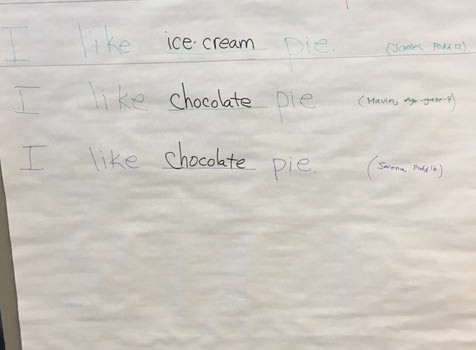
2.Read the story. Pause after each page to model saying a single word and/or a phrase to go with it. The child should have access to their communication system. At the minimum, they should have 4 core words to choose from, accessing it in their least:
a.Core-4: I, LIKE, LOOK, OH NO! (or, Uh-OH!) work very well for each page of this book. The Core 4 works great for beginning communicators:
i.Program on a speech generating device, such as the Go Talk 4
ii.Make 4 symbols and place on an eye gaze frame
iii.Core-9: I, LIKE, LOOK, YOU, OH NO!, TURN, STOP, AGAIN, WHAT
b.AAC navigation to FRINGE might take place to WH Questions, Days and times, Special, Clothing, People: hat, Food: pie, Joke, funny, Verbs: like, love, eat, Yummy, friend.
3.Continue Reading: Pause and allow the child to say something about each page. Consider using low tech symbols that match what your child says and tape it on the page as you read along (if 1:1 reading).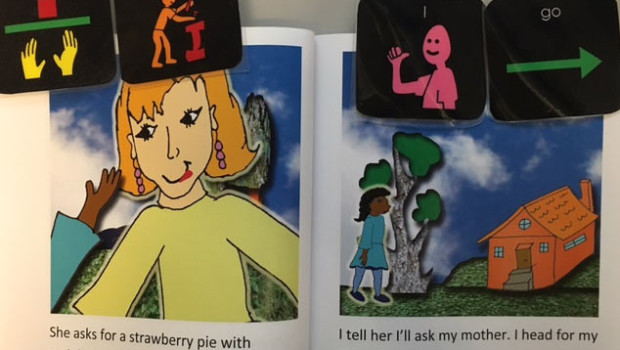
4.If you are reading to a class, copy the picture of each page and place the expressed words (symbols) next to the page, as spoken by your students. This will end up looking like a SHARED READING & TALKING activity! (I like to write who said the comment and how they said it.)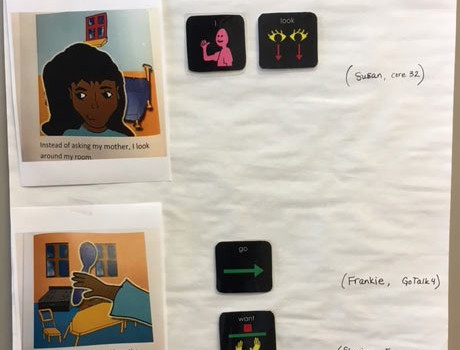
5.After reading the story, it’s time to plan the classroom prank!!
6.We will choose WHO.
a.The principal!
b.If at home, perhaps choose a family member!
7.We will choose WHAT kind of PIE to create:
a.A paper pie made of many “ingredients” such as:
i.Buttons
ii.Pom-poms
iii.Glitter
iv.Frayed paper
v.Paperclips
b.Everyone will choose an object in the classroom either by shared co-navigation to an art page or by simply choosing items on the teacher’s desk!
8.We will construct a big pie out of paper and placed it in a real pan!
a.We will take turns putting our “ingredients” in the “pie”
b.We will take turns choosing what color paper to use
9.Important step! Program devices to have the phrase, “April Fools!” and make sure no one is without a device. If you are at school, borrow some big macs from other classrooms if you have to! No teacher should talk with their own voices. Staff (and, if at home, family) should use a device, too! Model how fun talking with devices can be!
10.Wrap up the device in foil and walk down to the Principal’s office using our assistive walking/moving devices (wheelchairs, walkers). (Or, if at home, call the family member to the kitchen where you “made” the pie!) We will present it to the Principal with the following script:
a.We made a pie for you.
b.We hope you eat it!
c.Have some!
d.(*Wait for the Principal to look at the pie)
e.When the Principal sees that it is not a real pie, we will ALL USE OUR DEVICES TO SAY, “APRIL FOOLS!!!!”
You can download Karen’s lesson plan for this book here.
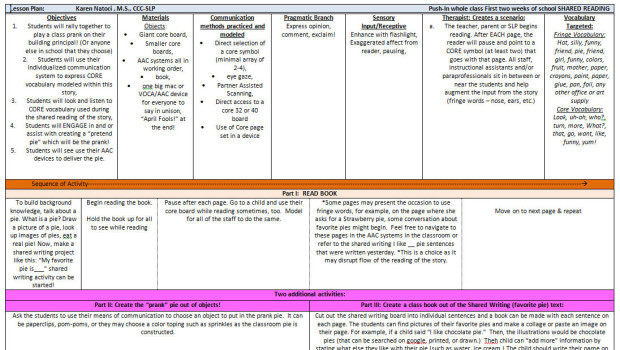
Filed under: Featured Posts, PrAACtical Thinking
Tagged With: classroom, literacy, reading
This post was written by Carole Zangari

